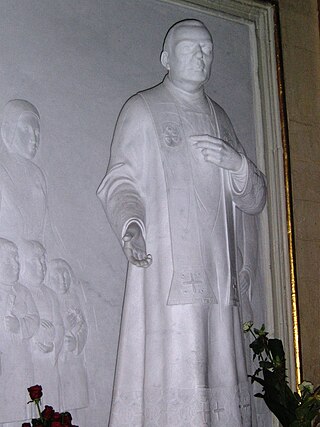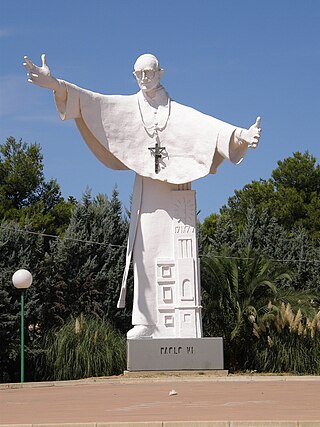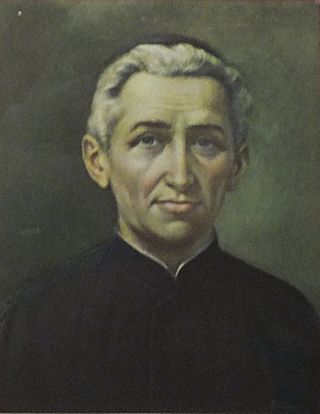
Józef Bilczewski was a Polish Roman Catholic prelate who served as the Archbishop of Lviv from 1900 until his death. He served as a theological and dogmatics professor in the Lviv college after himself having earned two doctorates in the course of his own studies. He earned a reputation as a learned and cultured man; these qualities led to Emperor Franz Joseph I nominating him for the Lviv archdiocese as its head. Pope Leo XIII named him as its archbishop and he set to work prioritizing a range of different pastoral initiatives aimed at revitalizing the faith within people and also prioritizing ecumenical cooperation with other denominations.

Giovanni Antonio Farina was an Italian Catholic bishop known for his compassionate treatment of the poor and for his enlightened views of education; he was sometimes dubbed as the "Bishop of the Poor". He served as the Bishop of Vicenza and later as the Bishop of Treviso; he is also known for ordaining the future Pope Pius X to the priesthood.

Filippo Smaldone was an Italian Roman Catholic priest and the founder of the Salesian Sisters of the Sacred Hearts. Smaldone is best known for his extensive work with the deaf during his lifetime. Smaldone was a gifted preacher known for his commitment to proper catechesis and to the care of orphans and the mute, which earned him civic recognition.

Zygmunt Gorazdowski was a Polish Roman Catholic priest and the founder of the Sisters of Saint Joseph. Gorazdowski suffered from tuberculosis during his childhood which impeded his studies for the priesthood in what required him to take time off in order to recover before he could be ordained. Once he was ordained he served in various parishes while setting up homes for orphans and single mothers as well as hospices and other establishments for a range of people; he was a prolific writer of catechism and other religious notes for the benefit of his flock.

Ciriaco María Sancha y Hervás was a Spanish cardinal of the Roman Catholic Church who served as the Archbishop of Toledo in addition to being the Primate of Spain and the Patriarch of the West Indies. He established the Sisters of Charity in 1869.
Jaime Hilario Barbal – born Manuel Barbal i Cosán – was a Spanish Roman Catholic and a professed religious brother from the Institute of the Brothers of the Christian Schools. He served for almost two decades as a teacher in the schools that his order managed until being caught up in the turmoil of the Spanish Civil War that saw the forces of the Second Spanish Republic execute him.

Benedetta Cambiagio Frassinello was an Italian Roman Catholic professed religious and the founder of the Benedictine Sisters of Providence. Frassinello married to appease her parents in 1816 but the couple decided to lead a chaste life and both pursued a call to the religious life with Frassinello joining the Ursulines in Capriolo at Brescia. But husband and wife later reunited after setting out to establish schools for the education of girls and the pair moved back to Genoa where she founded her order in 1838 based on the Benedictine charism.

Luigi Guanella was an Italian Roman Catholic priest. He was ordained a priest on May 26, 1866 in Como, and was assigned to a small parish in Savogno. Luigi is the founder of several religious institutes: the Daughters of Saint Mary of Providence (1890) and the Servants of Charity alongside his friends David Albertario and Giuseppe Toniolo. Guanella also founded the Pious Union of Saint Joseph (1914) with his supporter and first member Pope Pius X. These religious communities focused on the relief of the poor throughout the world. The Servants of Charity motto reads "In Omnibus Charitas", which became the cornerstone for Guanella's own life.

Franz Josef Rudigier was an Austrian Roman Catholic prelate and served as the Bishop of Linz from his appointment in 1853 until his death. Much of his local diocese grew due to his vigorous in promoting evangelic zeal and fundamental religious principles. He became the intellectual figurehead for Catholics in their struggle with liberalism. He promoted the Christian press and took a visible stand defending the 1855 concordat, when liberals annulled it without papal consultation in 1870. A beatification process for Rudigier was initiated under Pope Pius X in 1905 and he was titled as a Servant of God. The confirmation of his life of heroic virtue allowed for Pope Benedict XVI to name him as Venerable in 2009.
Arcangelo Tadini was an Italian Roman Catholic priest. Tadini was ordained as a priest in 1870 and went on to found a religious congregation dedicated to the poor and ill while taking advantage of the Industrial Revolution to support women in work and education. Tadini was disabled due to a lame leg he had after suffering an accident while he studied for the priesthood. He initiated various parish initiatives and a relief fund for the aged and the ill.

Stanisław Kazimierczyk was a Polish Catholic priest and a professed member of the Canons Regular of the Lateran. He became noted for his ardent devotions to both the Eucharist and to his personal patron saint, Stanislaus of Szczepanów, as well as for his charitable dedication to the ill and poor of Kraków.

Giulia Salzano was an Italian Roman Catholic professed religious and the founder of the Catechetical Sisters of the Sacred Heart of Jesus (1905). Salzano served as a teacher prior to becoming a religious and since 1865 worked in Casoria as a teacher for children where she demonstrated herself as an apt catechist and instructor.

María del Carmen Sallés y Barangueras, also known by her religious name Carmen of Jesus, was a Spanish Roman Catholic professed religious and the founder of the Missionary Sisters of the Immaculate Conception. Sallés is best known for being a strong advocate of both genders being equal and a staunch defender of the rights of women, since she made this the focus of her life from the beginning of her entrance into the religious life.

The cause for the canonization of Pope Paul VI, who died in 1978, commenced in 1993 and he was canonized on 14 October 2018. After having been proclaimed a Servant of God and declared Venerable, he was beatified on 19 October 2014, after the recognition of a miracle had been attributed to his intercession, and declared a saint by Pope Francis on 14 October 2018.

Nicola Saggio was an Italian Roman Catholic professed oblate of the Order of Minims.
Francesco Antonio Marcucci was a Roman Catholic Italian bishop and a member of the Secular Franciscan Order. Marcucci was also the founder of the Pious Workers of Mary Immaculate.

Lodovico Pavoni was an Italian Roman Catholic priest who administered in Brescia where he lived. He paid close attention to the needs of males and was concerned with their education. He was to establish – in 1825 – his own religious congregation to assist in his mission: the Sons of Mary Immaculate which came to be known also as the "Pavoniani".

Blessed Luigi Monza was an Italian Roman Catholic priest and the founder of the Secular Institute of the Little Apostles of Charity. Monza's pastoral mission was defined with catering to the needs of the poor and the sick and used his new congregation as a means of spreading this mission.

Joseph Kugler, OH was a German Roman Catholic professed religious of the Brothers Hospitallers of Saint John of God. Kugler entered the congregation in 1893 and assumed his religious name Eustachius upon admittance into ¢novitiate.
Serafino Morazzone was an Italian Roman Catholic priest. Morazzone served as a simple parish priest in Lecco from his ordination as a priest in 1773 until his death and became noted amongst the faithful for his personal holiness and dedication to the sacraments.
















